NORTH WALES COAST RAILWAY :NOTICE BOARD
Rheilffordd arfordir gogledd Cymru: Hysbysfwrdd
13 February 2024




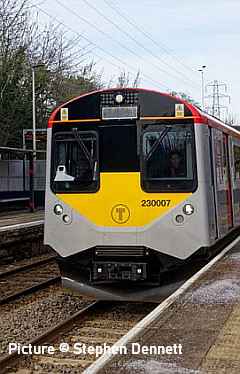
Contributions to the Notice Board are welcome, although they may not always be used, due to time constraints, especially if they don't follow the advice and file name convention given on the Contributions Page.
Forthcoming events
Charter trains and meetings may be subject to cancellation or postponement. See our Calendar Page for club, society and tour operator details.
February 2024
Saturday 24 February Chester Society for Landscape History Annual General Meeting followed by: “The Chester to Holyhead Railway” Dr Philip Lloyd. 2 pm at St. Columba’s Church Hall Plas Newton Lane / Newhall Road Chester CH2 1SA Admission: Members Free, Visitors £4, Student Visitors £2
March 2024
Friday 1 March Clwyd Railway Circle The Dockers Umbrella The History of The Liverpool Overhead Railway. - Ken Pye FLHU
Friday 1 March (note the first Friday of the month). Altrincham Electric Railway Preservation Society Dennis Flood. "Edge Hill Motive Power Depot". Dennis will entertain us with tales from his career on the footplate in the 1960s.
Saturday 2 March Railway Touring Company The Cheshireman loco 45596 London Euston - Chester
21 March Statesman Chester - Windsor and Eton Central. Pickups in North Wales borders.
April 2024
Thursday 4 April Pathfinder Reading - Pwllheli via Crewe
Friday 5 April Midland Pullman Plymouth to Llandudno
Friday 12 April. Altrincham Electric Railway Preservation Society David Beilby. "Transport around the World by GEC and its predecessors". A joint meeting with the Irish Railway Record Society Manchester branch.
Thursday 18 April Pathfinder Tours The Cambrian Coast Express East Midlands Parkway - Shrewsbury - Pwllheli
Thursday 18 April Midland Pullman Wolverhampton - Chester - Carlisle
Tuesday 23 April Midland Pullman Chester - Aviemore
May 2024
6 May Statesman Woking - Llandudno via Bath Spa and Crewe for Llandudno Victorian Extravaganza
Thursday 16 May Pathfinder Tours The Cambrian Coast Express Cardiff - Pwllheli
Saturday 25 May Railway Touring Company Manchester Piccadilly - Llandudno and Holyhead Steam: 5596 Bahamas
June 2024
8 June Vintage Trains Dorridge - Blaenau Ffestiniog Steam and 47 773 via Crewe. Diesel on Blaenau branch
21 June Northern Belle - Crewe Two tours - lunch and afternoon tea. Round trip from Crewe via pickups at Chester and Wrexham.
Saturday 22 June Midland Pullman Holyhead - Carlisle

Saturday 22 June North West Rail and Transport Collector's Fair, Crewe Alexandra Football Club 10:00 - 3:30
Thursday 27 June Midland Pullman Crewe - Chester - Wrexham - Paignton
July 2014
Tuesday 16 July Midland Pullman Holyhead - Paignton
27 July Midland Pullman Crewe - Paignton
August 2024
14 August Statesman Telford Central - Carlisle
pickups Shrewsbury, Gobowen, Chirk, Wrexham General, Chester, Frodsham, Warrington BQ
September 2024
4 September Statesman High Wycombe - Blaenau Ffestiniog
Thursday 5 September Pathfinder Tours The Cambrian Coast Express Bristol - Pwllheli
Friday 6 September Clwyd Railway Circle The Denbigh, Ruthin and Corwen Railway in the Vale of Clwyd - Fiona Gale
12 September Pathfinder Cambrian Coast Express Cardiff Central - Pwllheli
Sunday 15 September Steam Dreams 'Welsh Dragon' steam-hauled London Paddington - Shrewsbury, then diesel through to Pwllheli. For more on this and this and the next two entries see the Steam Dreams website.
Wednesday 18 September Steam Dreams 'Welsh Dragon' steam hauled Bangor - Crewe, then diesel to Cardiff via the Heart of Wales line
Thursday 19 September - Steam Dreams 'Welsh Dragon' steam hauled Cardiff to London Paddington via Gloucester and the Golden Valley line
21 September - Northern Belle Telford - Carlisle pickups Shrewsbury, Wrexham General, Chester.
October 2024
Friday 4 October Clwyd Railway Circle Wrexham’s Second Railway Mania - David Parry
November 2024
Friday 1 November Clwyd Railway Circle Chinese Steam in 2001 and 2003 - Phil Thomas
(see our Calendar page for meeting venues)
North Wales Coast Railway website created and compiled by Charlie Hulme
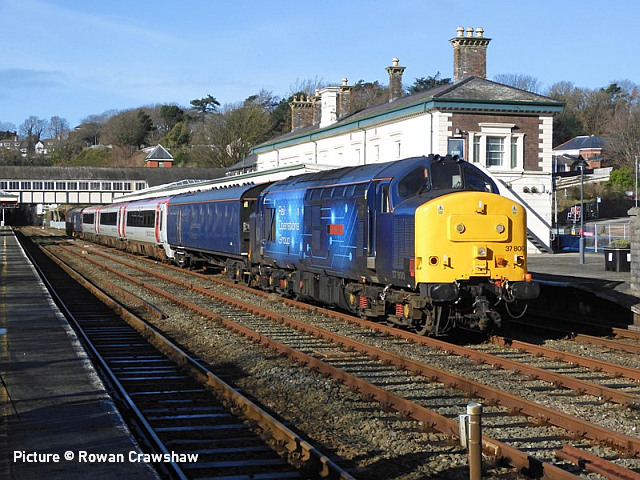
37800 pauses at Bangor while taking away 175 114 for its last time, 12 February. Picture by Rowan Crawshaw.
The final version of this week: additions start here
News Pictures
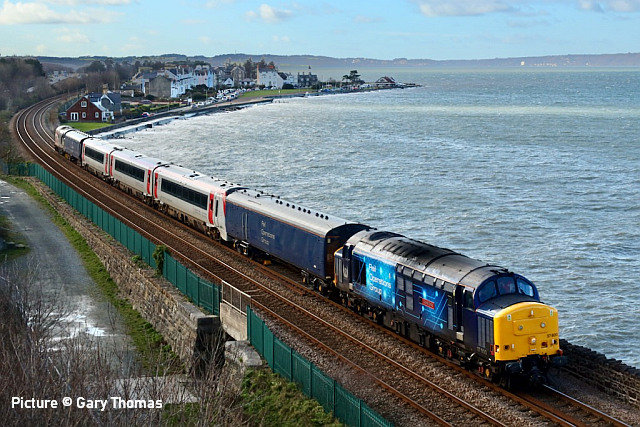
On 12 February ROG locos 37 800 and 37 510 travelled with translator vehicles from Crewe South Yard to Holyhead to collect 175 114, which has been languishing there for some time. Gary Thomas photographed the train passing Llanfairfechan ...
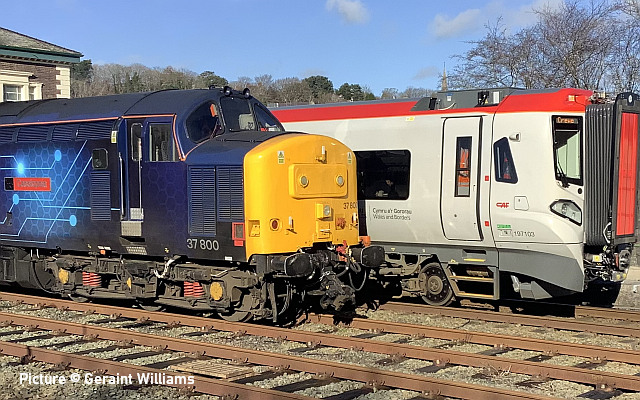
... Seen passing 197 103 at Bangor waiting for 197 103 (Geraint Williams).The destination was to Barton Under Needwood, maintenance depot for Voyagers, which also does work for other companies.
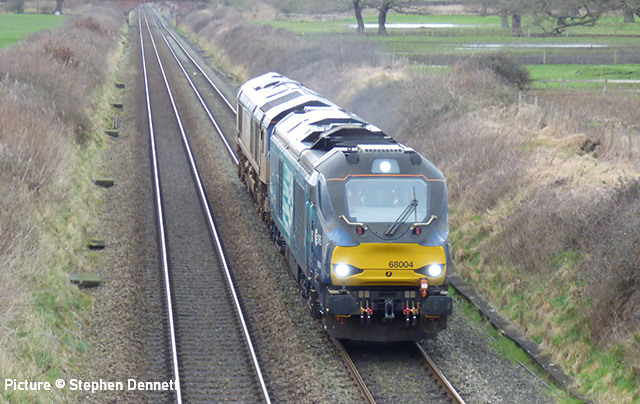
68 004 Rapid leads DRS 66 426 past Hatton Lane bridge, Waverton with 0Z27, Chester to Crewe Gresty Bridge light engine run on 5 February.
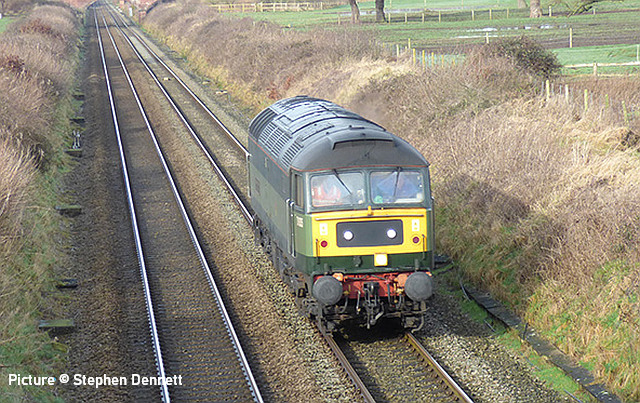
LSL 47 805 (D1935) comes past Hatton Lane bridge, Waverton with 0K42, Chester to Crewe HS light engine run on 7 February.
A Borderlands Ride - by Alan Crawshaw
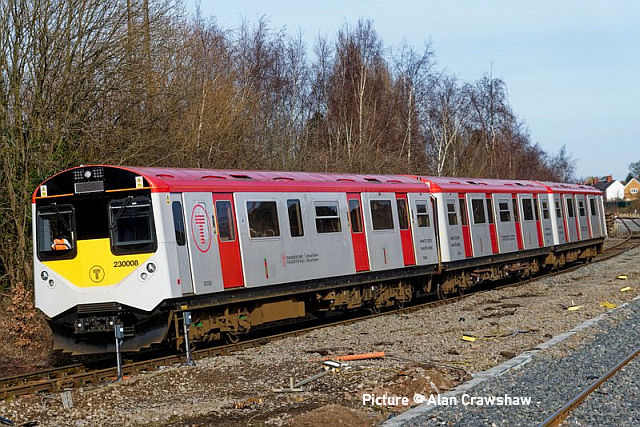
Almost forty years after moving to north Wales, we made our first journey on the Borderlands Line. We boarded the 09:52 at Llandudno Junction, alighting at Shotton. The first train in either direction from the high level platforms was a 197 so we took the 10:45 to Wrexham General, photographed 230 008 arriving (above), then sprinted over the bridge to board for the spur to Central and then back into England.
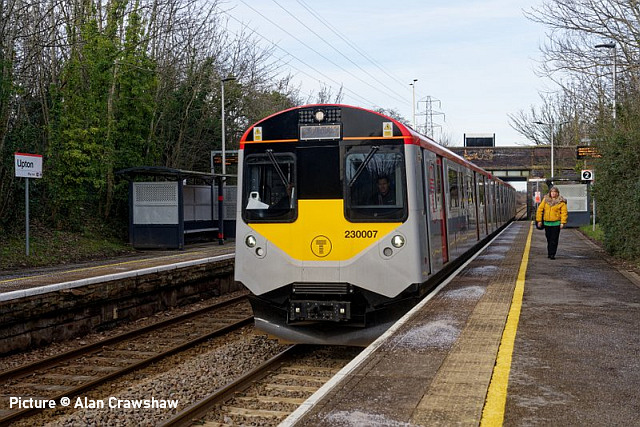
Real Time Trains told us that the unit would be taken out of service on arrival at Bidston so we alighted at Upton for a short wait until 230 007 rolled in. This connected well at Shotton with only a few minutes wait for the same 197 to collect us on its return from Manchester airport.
There were few passengers on the 230s. My impression of them was positive, better visibility through big windows compared with the 197 and the toilet seat didn't require a hand to stop it flopping back.
Observations at Crewe - by Richard Snook
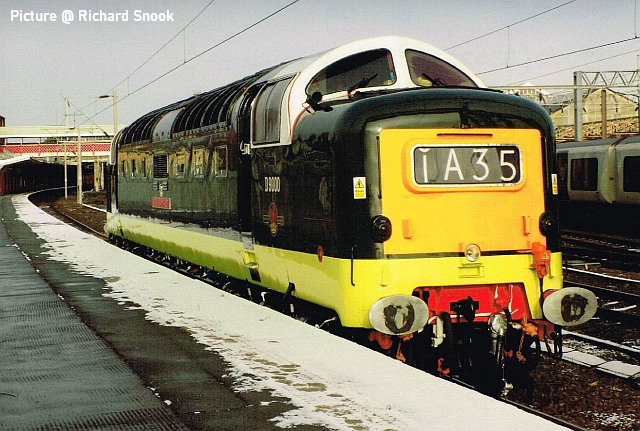
Mid-January found Deltic D9000 Royal Scots Grey from Chester on a test run back to Locomotive Services Co (old Diesel Depot) on 16 January.
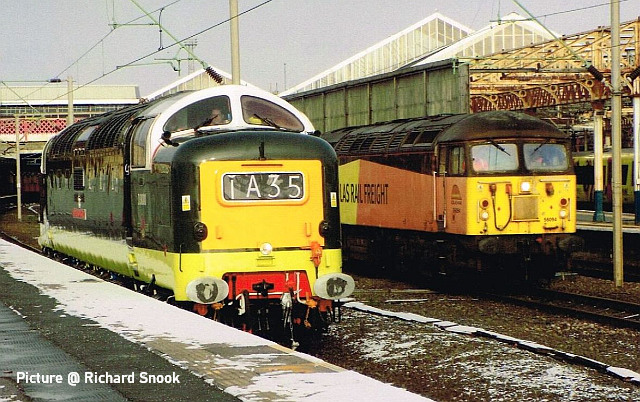
56 094 passes on a train of spoil wagons destined for Longport.
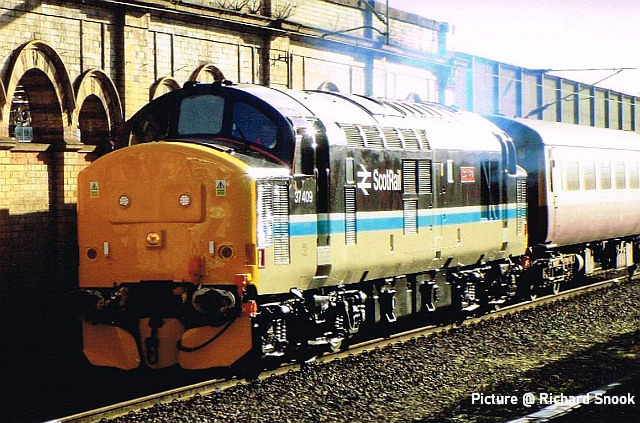
Noted on the 19th was 37 409 Loch Awe (ex Lord Hinton) in Scotrail livery - a livery it never carried - on a coach transfer from the LSL Co.sidings to Crewe International Electric depot.
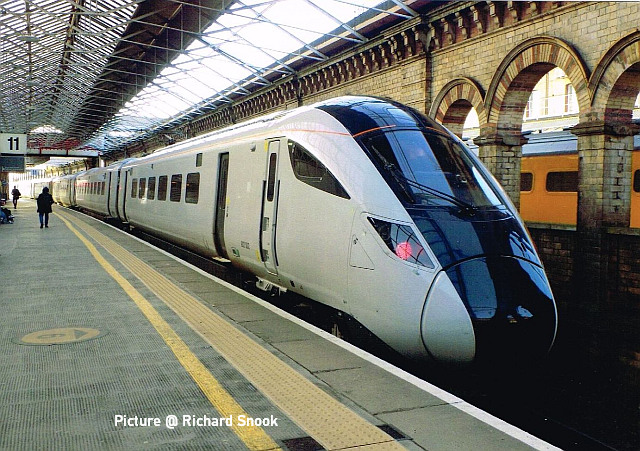
Noted also at Crewe on 1 February new class 807 002, an all-electric EMU for Avanti on test. Ten of these have been ordered.
Shotton Coils
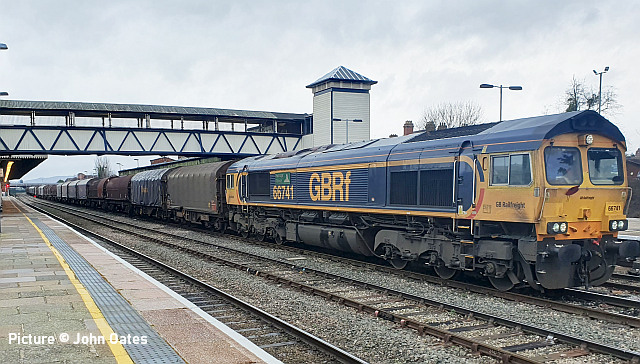
66 741 Swanage Railway complete with poppy on the front cab rail passes Hereford station on 6 February with 6V75 09:31 Dee Marsh to Margam steel empties (Picture by John Oates).
The closure of the blast furnaces at Port Talbot casts a shadow on the Tata steel coating works which currently receives coils of sheet steel on these trains. The plant has recently had new machinery installed, but Tata apparently wants to sell it. Port Talbot will eventually have a new electric arc furnace for recycling steel, which may be suitable, but otherwise steel will be imported, maybe from the Netherlands or even India. Around 2000 jobs will be lost. Sadly, there is now no works remaining in this country that can produced 'virgin' steel.
Once the Shotton site itself also had a large making operation which was closed down in 1980, with the loss of around 6500 jobs which receives its material from that works.
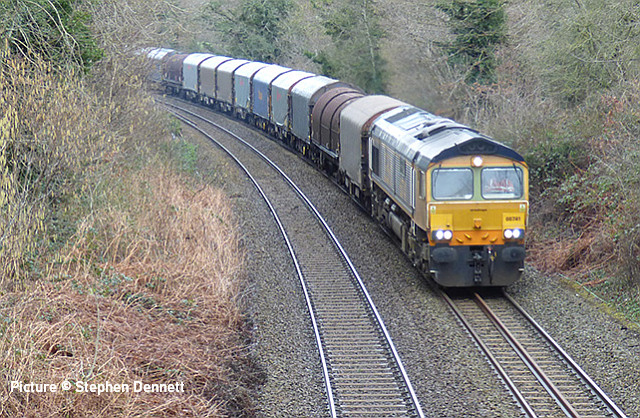
66 741 passes Slack Lane bridge between Hawarden and Buckley with 6V75, Dee Marsh to Margam returning steel empties, 7 November (Stephen Dennett).
Wrexham relaying - report by George Jones
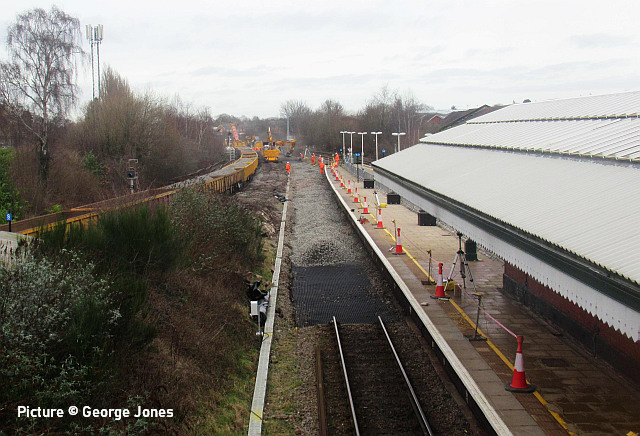
A massive engineering effort has been underway to renew the connection from the main Shrewsbury - Chester line and onto the Bidston line with track renewal through platform 3 as old track ripped out and new base ballast laid as of 12 noon 27 January (above) a view from the footbridge.
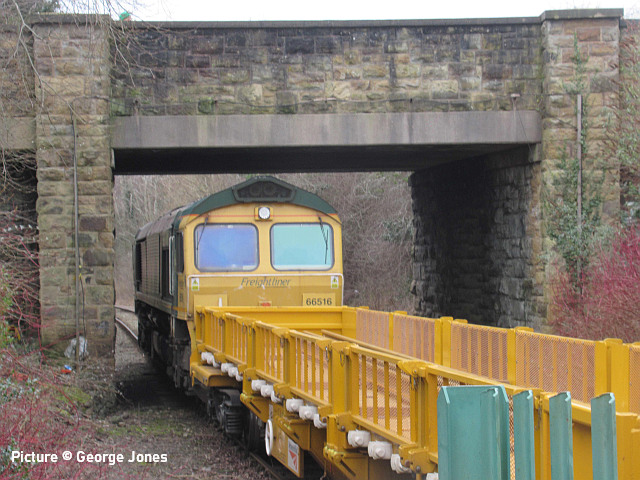
66 516 in attendance, ready to carry away the spoil.
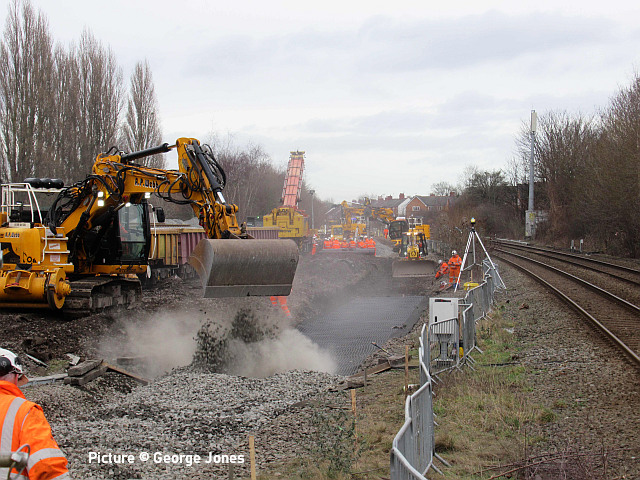
Excavations underway and more ballast trains parked up north of the works site with 66 504 and 66 414 with the heavy lift crane on standby for lifting in new track section stored in the Crispin Lane works compound.
Tamper DR75407 awaits in the bay platform at south of platform 1, This part of the job was to be completed in time for resumption of service Monday morning; meanwhile no trains ran on Sunday.
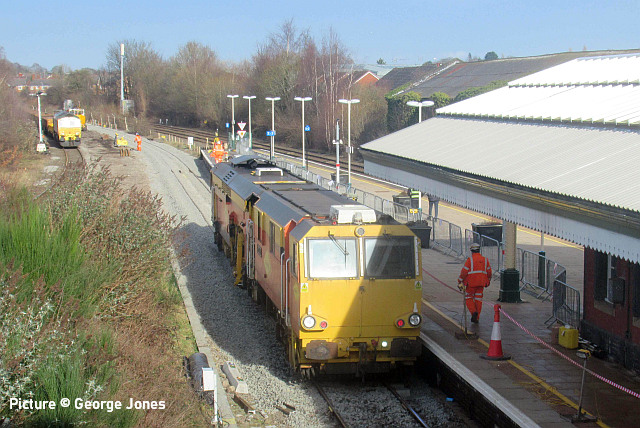
I went to Wrexham General at 13:00 on the Sunday to monitor progress and despite the General station being closed and forecourt in use for bus replacement services, I was able to access the footbridge with others and view the work on the platform 3 track. The work appeared to be coming to a conclusion with the tamper at work on the re-laid new track.
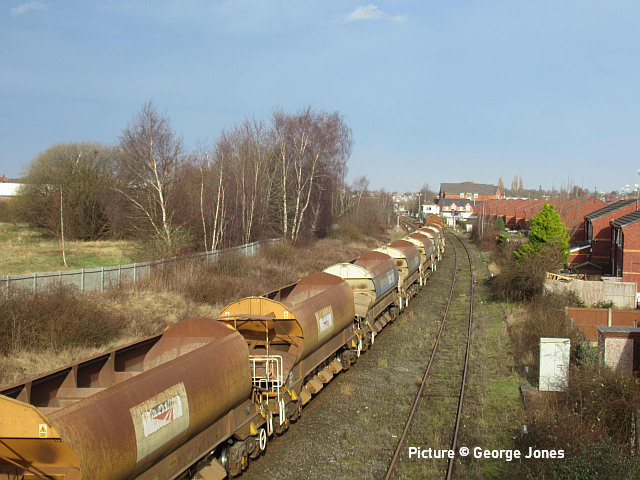
The crane and ballast hoppers had moved down to Croes Newydd so I went round to Ruthin Rd bridge to capture the formation top and tailed by 66s waiting to depart.
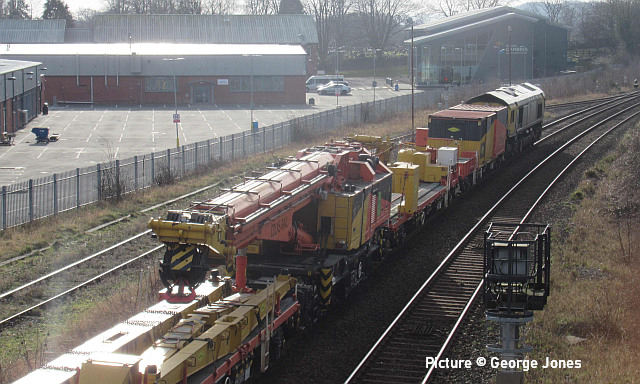
Likely the locos were 66 504 and 66 414 as seen prevously. Other work was underway renewing rails in platform 2 and the platform edging in platform 3. They would be back the following weekend, and another total line closure on 10-11 February.
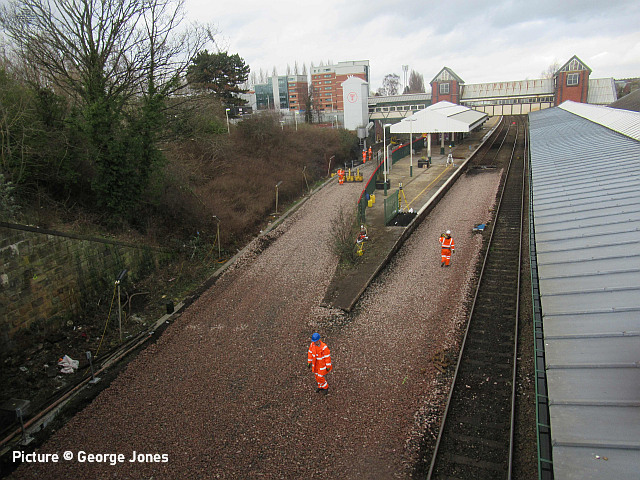
Some views from the of the third weekend of work, to renew the Bidston line connection was under on Sunday 11 February. At 1pm the lines at platform 2 and 3 base ballast was renewed and the south end point was in situ with track panels about to be replaced.
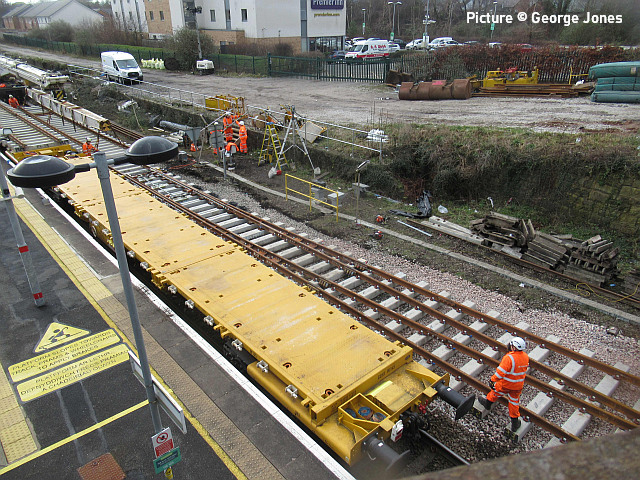
Crane DRK81613 in action lifting a panel under the road bridge ...
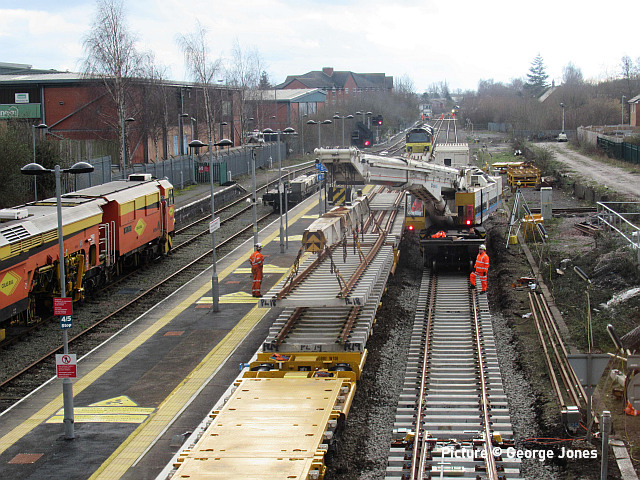
... with an unidentified Colas class 70 on the track panel train.
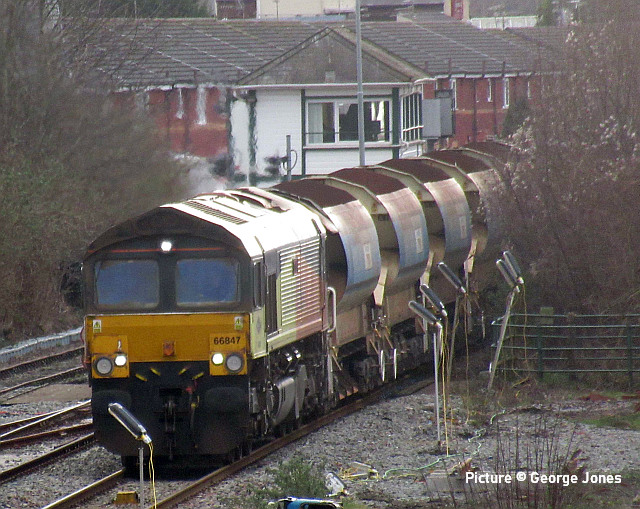
66 847 arriving with the auto-ballast wagons as in the attached sequence of pics from Mold Road bridge, this work completes the length through to Wrexham Exchange junction on the Bidston line An impressive piece of work.
Turn
of the century - Pictures by Tim Rogers
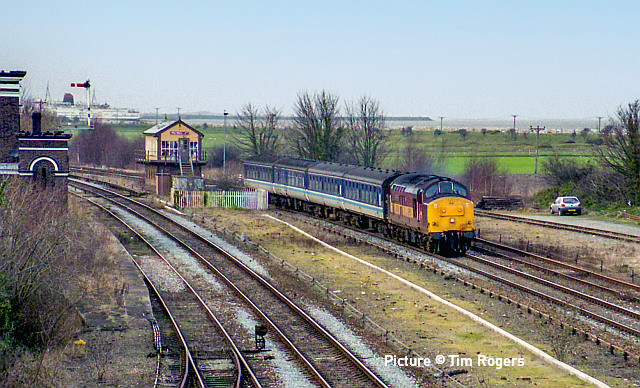
It has been thought that 37-hauled passengers trains would cease at the end of 1999, but this didn't quite happen. 37 401 Mary Queen of Scots was in charge of 1K67 12:51 Holyhead to Crewe on 7 February, seen passing Holywell Junction. 37 401 is still with us today, having recently been sold by DRS.
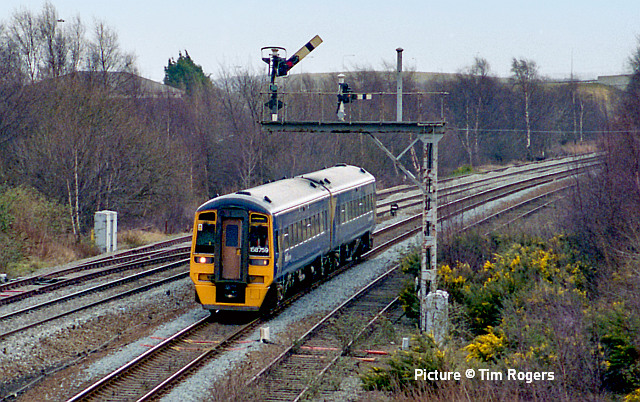
At this period, Coast trains were operated by First North Western, although this unit still carries the 'gold star' livery of short-lived North Western Trains franchise. 158 759, seen on 1D41 13:16 Manchester Piccadilly to Llandudno, is one of eight class 158s - 752 to 759 - allocated to First North Western primarily for Coast services. However, 158 759 was one of three (752-759) fitted with a 'First Class' compartment. This was for use on the trains to London from Rochdale and Blackpool as promised in the franchise agreement. These struggled for patronage, especially since they were slow barred from larger stations by Virgin; the last ran in May 2000.
752-759 disappeared from the Coast services after the line (with branches) was transferred to the Wales and Borders franchise in Septmber 2003.
From Dave Sallery's archive
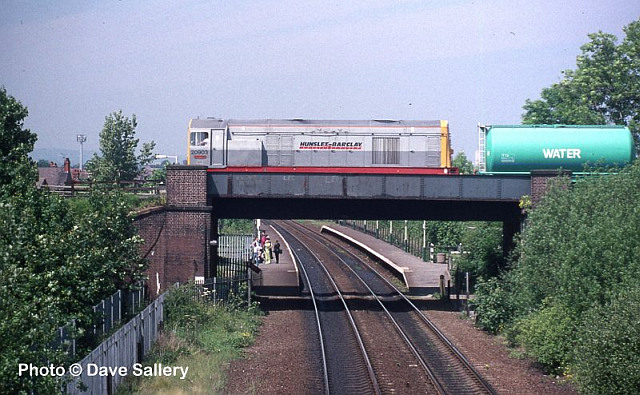
20 903 leads the weedkilling train at Shotton after treating the Merseyrail New Brighton and West Kirby lines, 3 June 1997.
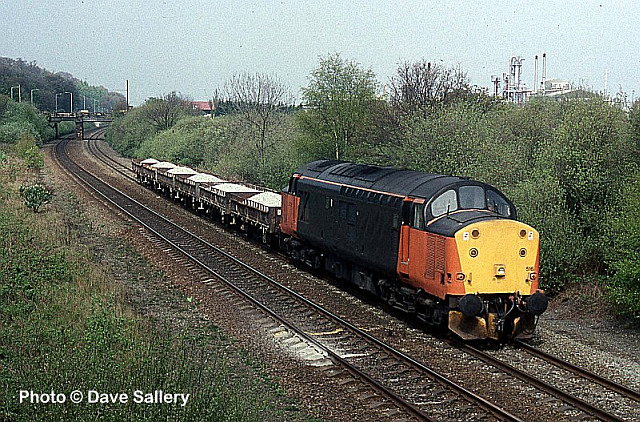
37 516 in unbranded Loadhaul livery near Mostyn with a loaded ballast train, 22 April 1997.
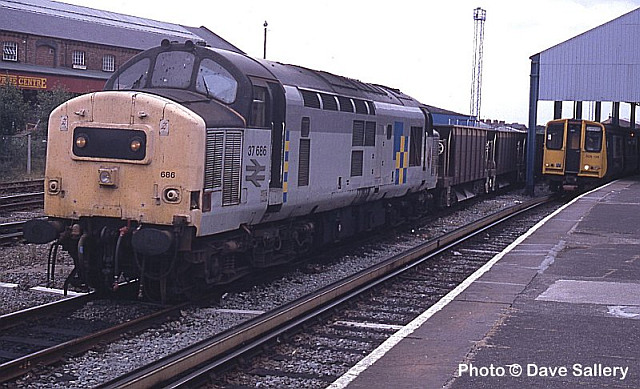
37 686, with its characteristic drooped nose, with ballast epties. at Chester on 9 April 1994.
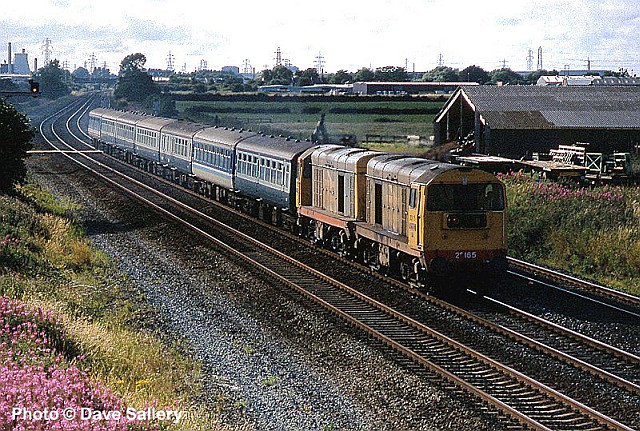
20 165 leads the Llandudno - Derby service near Sandycroft in July 1991.
Summer 1993 - recalled by Barrie Hughes
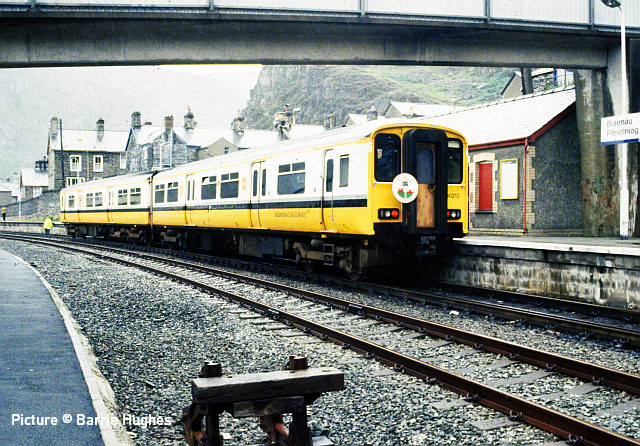
On 25 July 1993 Gwynedd Council teamed up with BR to hire in a Merseyrail unit, 150 213 for the Sunday Shuttle on the Conwy Valley line. This linked nicely into Ffestiniog Railway services. At this time there was a short siding on the BR side of the FR's island platform, the buffer stop of which can be seen in this view. Later the line was extended the full length of the platform but never used for regular train services due to its proximity to the Network run-round line.
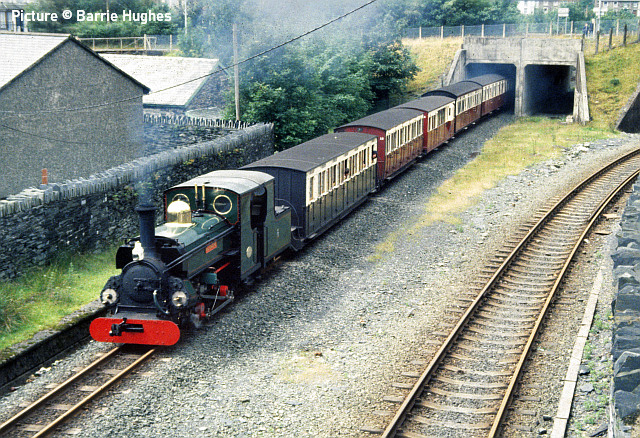
On the same date Blanche arrives with a motley rake of original and newer coaches. The unused second bridge portal was designed for a potential shuttle operation up the Dinas branch to the original FR terminus where services could link into an incline service into the Llechwedd Slate Quarry attractions. This has been discussed again in recent years with a Hydrogen powered experimental railcar group seeking to reopen the line which has received some trackbed clearance.
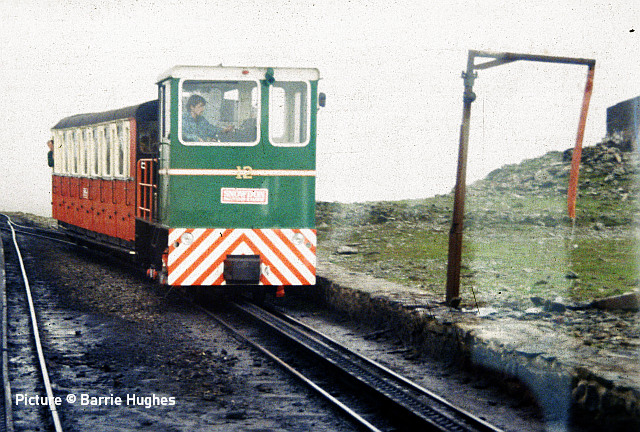
Possibly the same day, Snowdon Mountain Railway No.12 with a water column still in use by steam locos at Clogwyn passing loop (779 metres abouve sea level).
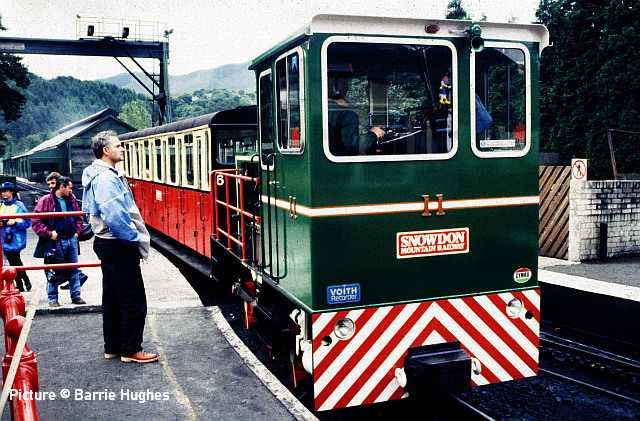
Diesel No.11 is seen shunting later in the day with the depot visible beyond Llanberis station. The railway bought four diesel locos (Nos.9-12) to reduce costs as steam operation costs over 15 times as much as diesel operation.
The first two appeared in 1986 and the final two in 1991 and 1992. These are 0-4-0DH and use Rolls-Royce (now Perkins) power units. The railway continues to operate its steam fleet with premium fares being available for these trains.
Between 1895 and 1823 eight steam locos were provided (Nos.1-8) of which No.1 was scrapped after derailing and falling down the mountainside on the opening day! Nos.7/8 are stored off site and thought not likely to return to service, leaving 5 active locos, some of which will be sidelined for refurbishment in any year. Currently Nos. 3/5/6 are operational supplementing the diesel service. The railway also purchased three diesel powered railcars in 1995 but these were withdrawn 8 years later and scrapped in 2010. The SMR intends to re-open on 23 March 2024, weather permitting. Early season running usually turns back at Clogwyn.
Looking Back: Nineteenth-Century Locomotives - by David Pool
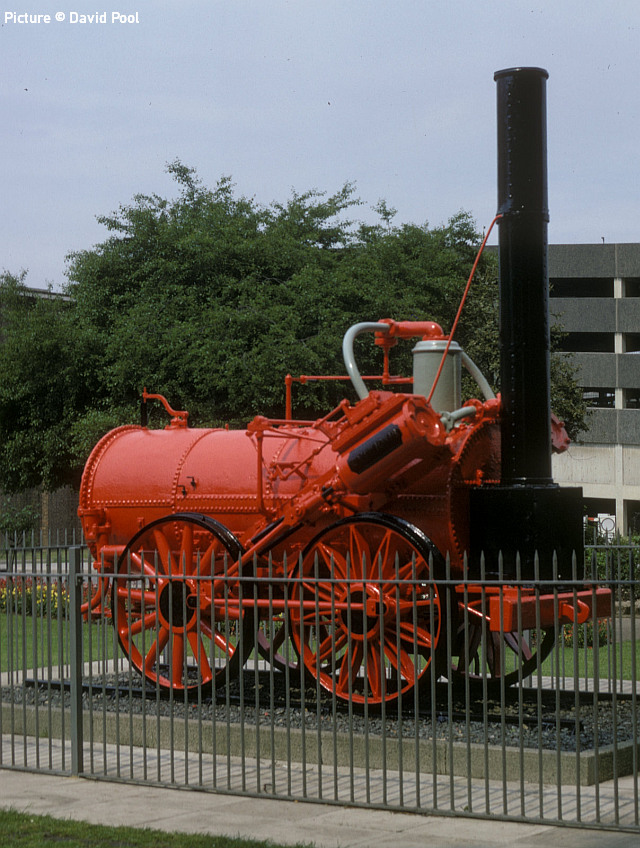
It is often assumed that the Liverpool and Manchester Railway was the first steam powered railway conveying passengers. A less successful but nevertheless earlier railway was the Canterbury and Whitstable Railway, which was opened in 1830, four months ahead of the L&M. The C&W (later known as the Crab and Winkle Line) was far from level, and had at first two rope worked inclines and one steam locomotive.
The Invicta was built by George and Robert Stephenson immediately after the Rocket, and delivered in 1829. It proved to be underpowered for the gradients, and a third rope worked incline was needed. The Invicta had boiler and other problems, and was taken out of service in 1839. With no buyers, it was put into storage, being recognised as a pioneer locomotive. Eventually it was displayed at Canterbury, where it remained for 70 years. On 28 May 1971 it was photographed in the Dane John Gardens, and after further restoration it is now in the Whitstable Museum and Gallery.
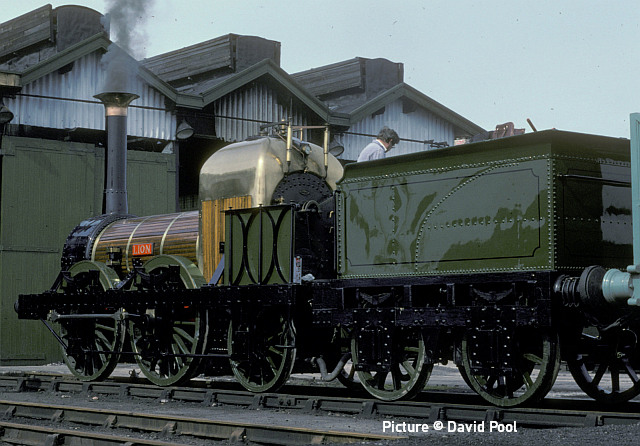
In 1838 Lion was built for the L&M Railway, and deservedly has had a much more eventful life. On 30 March 1980, just before the Rainhill Celebrations, it was at Steamport Southport, where it was being prepared for its appearance.
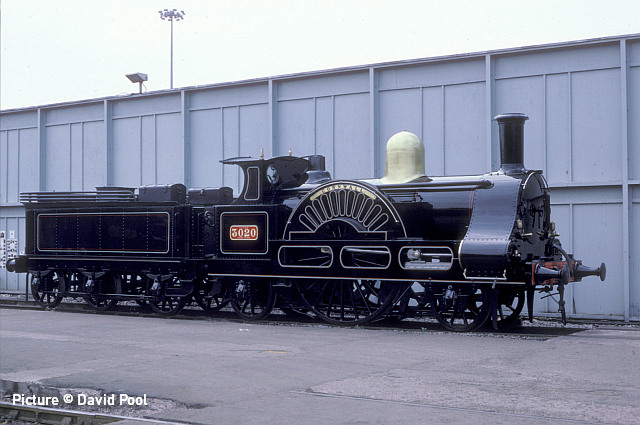
An open day at Crewe on 4 July 1987 gave me the opportunity to photograph Cornwall outside its usual museum location. This was a locomotive which had originally been built in 1847 to the design of Francis Trevithick, the son of Cornishman Richard Trevithick. With a 4-2-2 wheel arrangement, it had the boiler underneath the axle of the driving wheels, which unsurprisingly proved to be a problem – the axle for the trailing wheels passed through the firebox in a tube! In 1858 it was rebuilt by Ramsbotton as a more conventional 2-2-2, with the boiler above the axles, plus new valve gear and cylinders, and became one of the LNWR’s best locomotives, listed for preservation when it was retired in the 1920s.
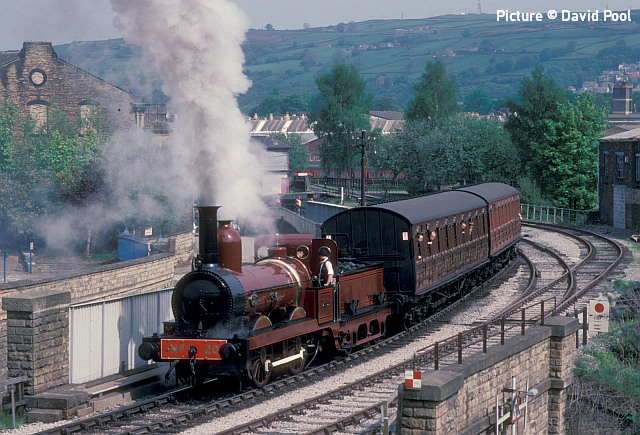
Claimed to be the oldest working steam locomotive in Britain, Furness Railway No 20 was built in 1863 by Sharp, Stewart & Co. of Manchester, as one of a batch of eight locomotives. When the rail traffic grew, it was found to be insufficiently powerful and was sold in 1870 to the Barrow Haematite Steel Co. where it took the number 7 and operated until 1960. After preservation as a static exhibit, it received several generous funds, enabling it to be rebuilt at the workshops of V.S.E.L. at Barrow with a new boiler and tender, returning to steam in 1998. It is currently on the Ribble Steam railway, but on 13 May 2000 it was a visitor to the Keighley and Worth Valley Railway, pictured leaving Keighley.
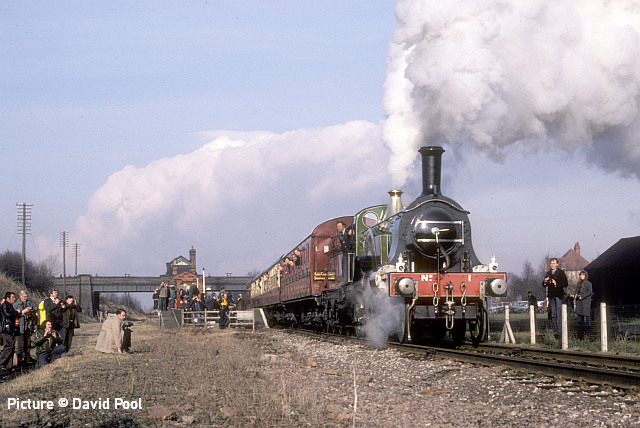
The next locomotive needs no introduction. Designed by Patrick Stirling and built in 1870 by the Great Northern Railway at Doncaster, No.1 soon demonstrated its speed and haulage capability between York and London. The 8ft driving wheels gave rise to the “Eight Footer” nickname for members of the class. It was steamed in the 1980s, and on 5 December 1981 it was visiting the Great Central Railway at Loughborough. The photographers at Quorn were lucky with the sunshine and even the direction of the wind!
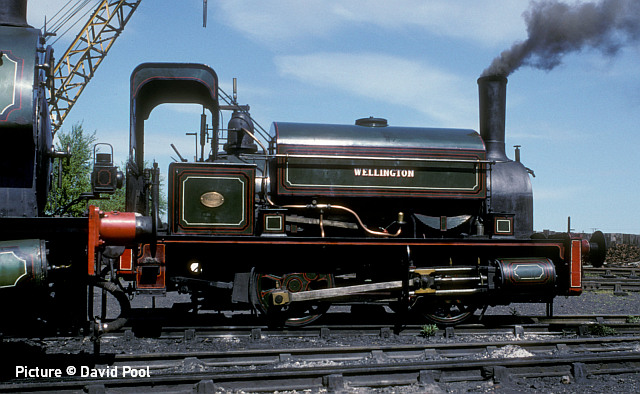
When I photographed Wellington at Marley Hill on the Tanfield Railway on 24 May 1998 I had no idea of its history. Built by Black, Hawthorn & Co. in 1873, it was Works No. 266, and used by contractors before being sold for operation in Ironworks and later in Limestone quarries. It was rebuilt in 1894, 1912 and finally 1935, ending its career at Wirksworth around 1973, and was said to be the oldest working steam locomotive in the world at that time. It moved to Tanfield for restoration in 1977, where it worked until 1998, then spending eight years at Beamish before returning to Tanfield, where it resides today.
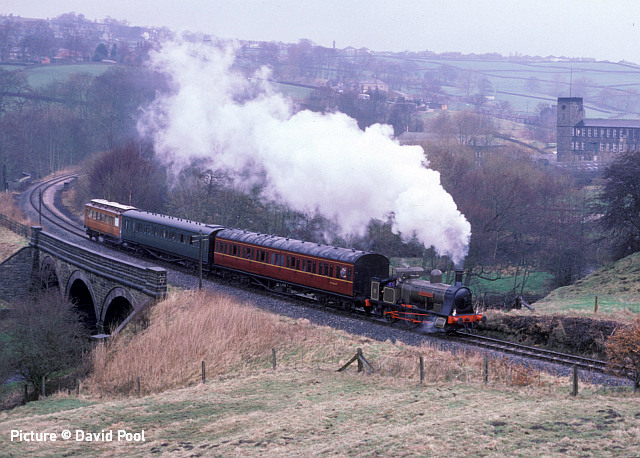
Bellerophon was built at Haydock Foundry in 1874 for use at Haydock colliery, although it occasionally assisted on the main lines with the workers’ annual trips to Blackpool. In 1947 the collieries were nationalised, and Bellerophon became an NCB locomotive, to be used at NCB sites until it was withdrawn in 1964. After Liverpool Museum declined to take it, Vintage Carriages Trust at Ingrow purchased it at a nominal sum, and raised funds for its restoration. It was on the Keighley and Worth Valley Railway on 19 March 1988 when I photographed it approaching Haworth, but it was not suitable for regular service trains on the KWVR, and has visited a number of preservation sites, notably the Foxfield Railway.
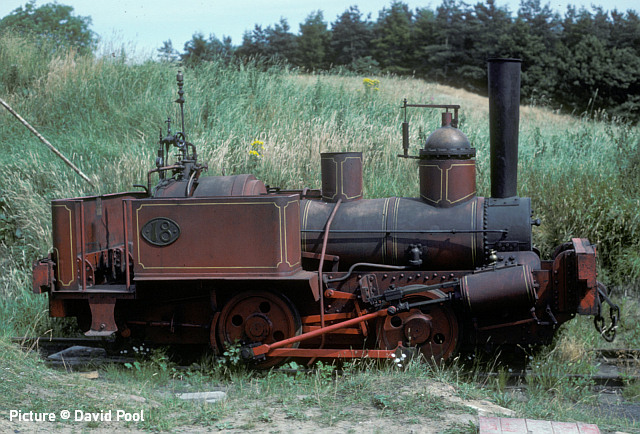
Few railway enthusiasts in the North East will not have heard of Seaham No.18. Built by Stephen Lewin at the Poole Foundry in 1877 (Works No.683), it worked at Seaham Colliery and the nearby Seaham Harbour. Large quantities of coal were moved from the Colliery at cliff top level to the staithes at the Harbour, where the coal was unloaded into ships. Several inclines were needed, mostly rope worked, although steam locomotives could be used for certain duties. No.18 could be seen at Seaham for many years, until the closure of the Collieries led to its eventual withdrawal after 93 years in service. Latterly it was used at Harbour level and under the staithes, where heavier locomotives would have been unsafe. A fascinating video by Alan Snowdon shows operations on the inclines and No.18 in service in 1963. No.18 was eventually moved to Beamish for restoration in 1975, but this proved to be more cosmetic than what was needed to enable it to be steamed regularly, and on 28 July 1983 it was looking forgotten, for some reason having been painted red. It later had a major restoration in 2012, regaining its green livery, and is currently being overhauled at Beamish.
Home page | Archive | Previous Notice Board